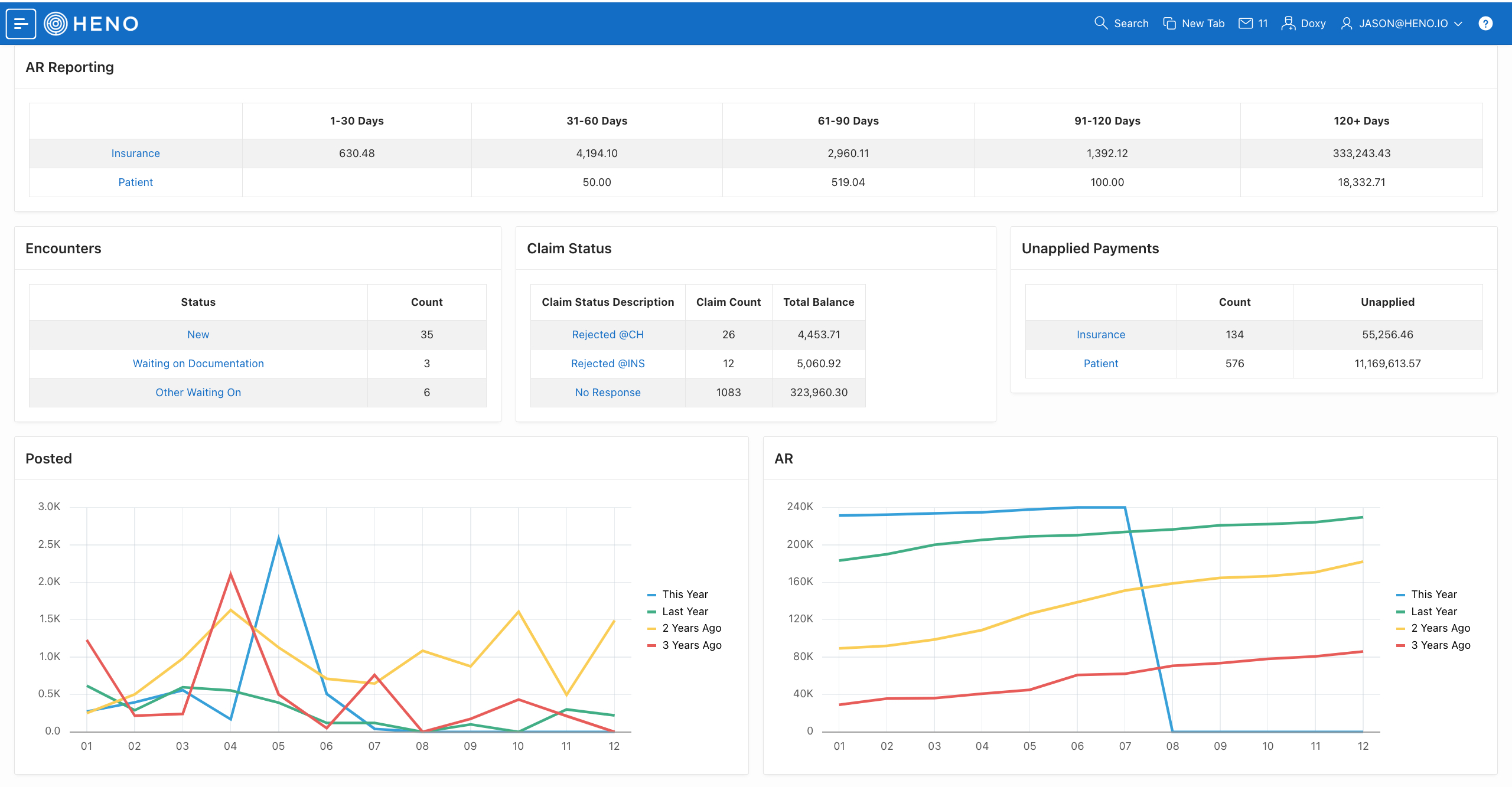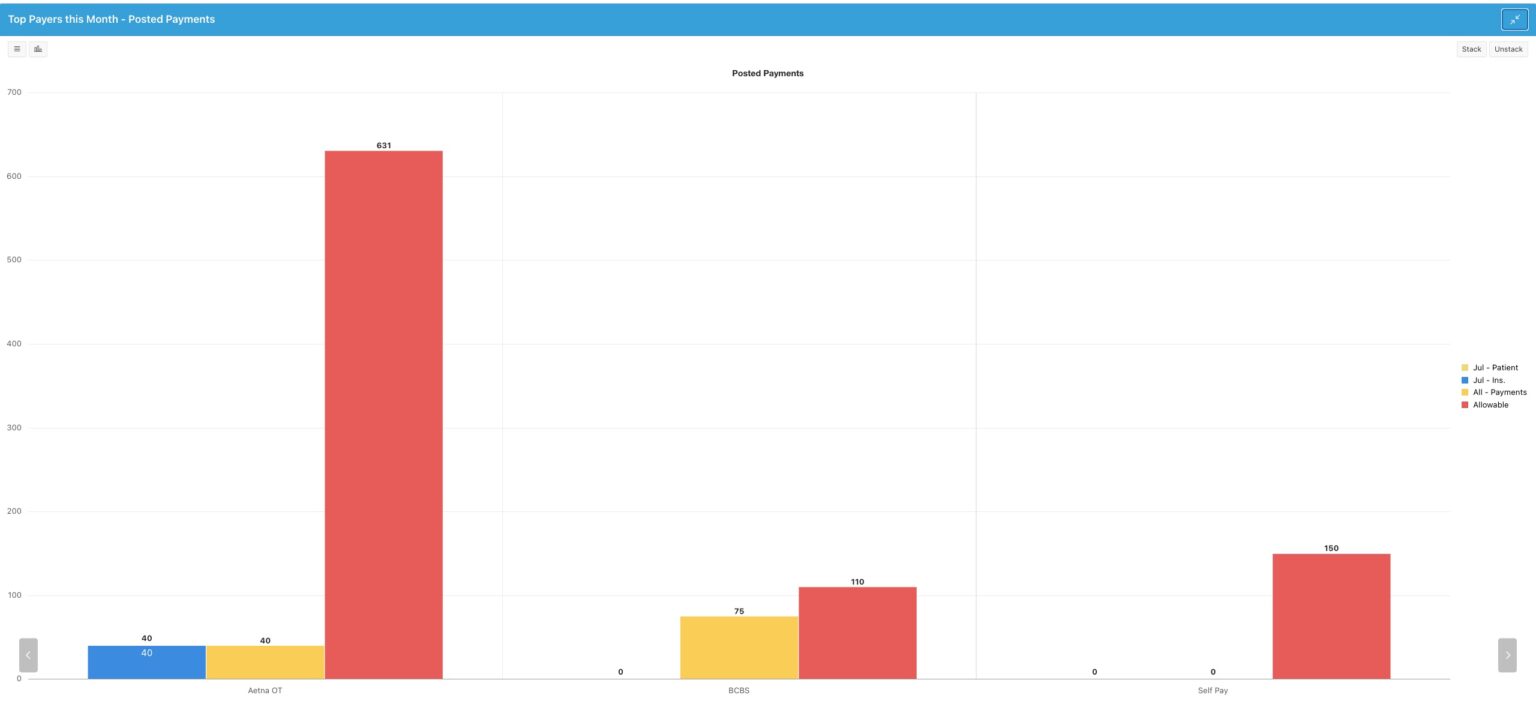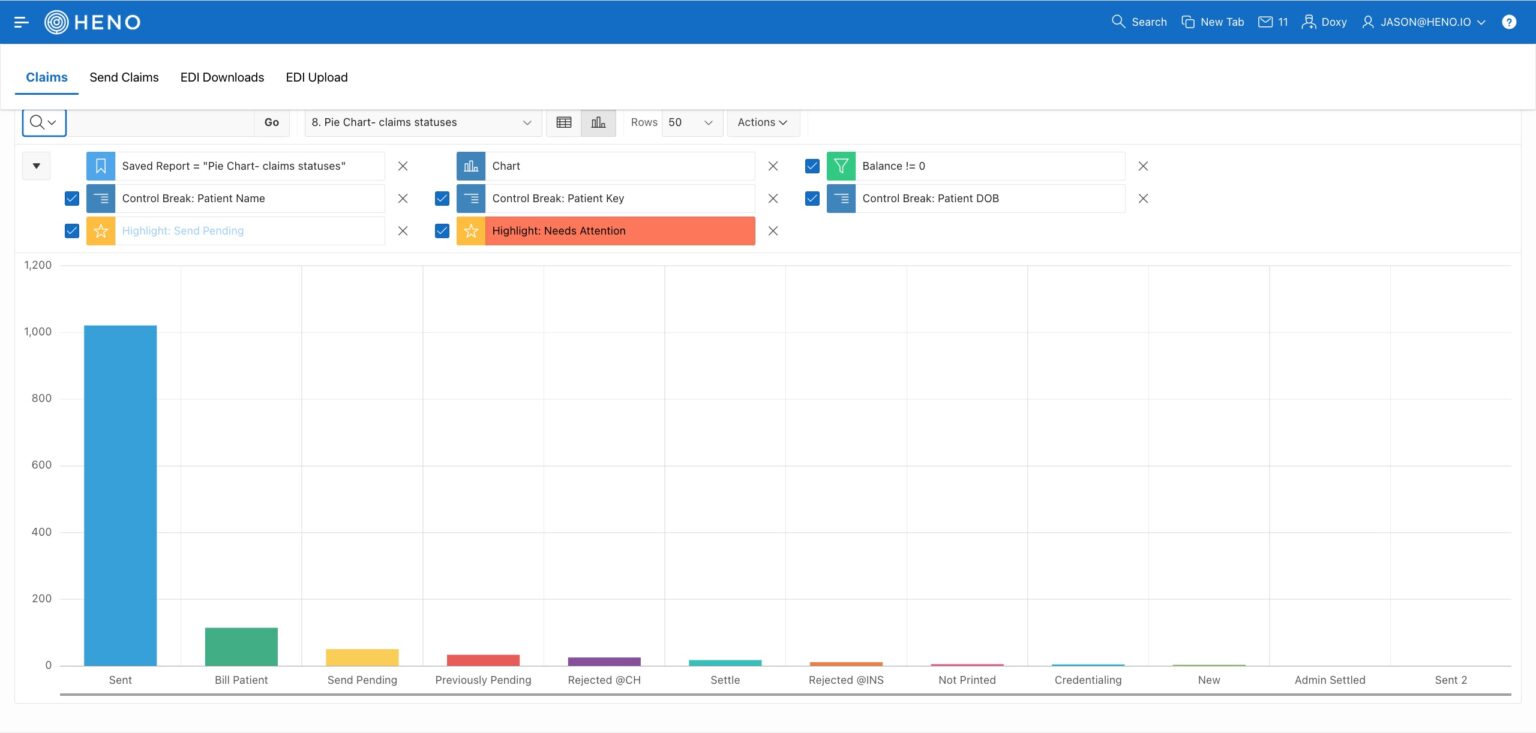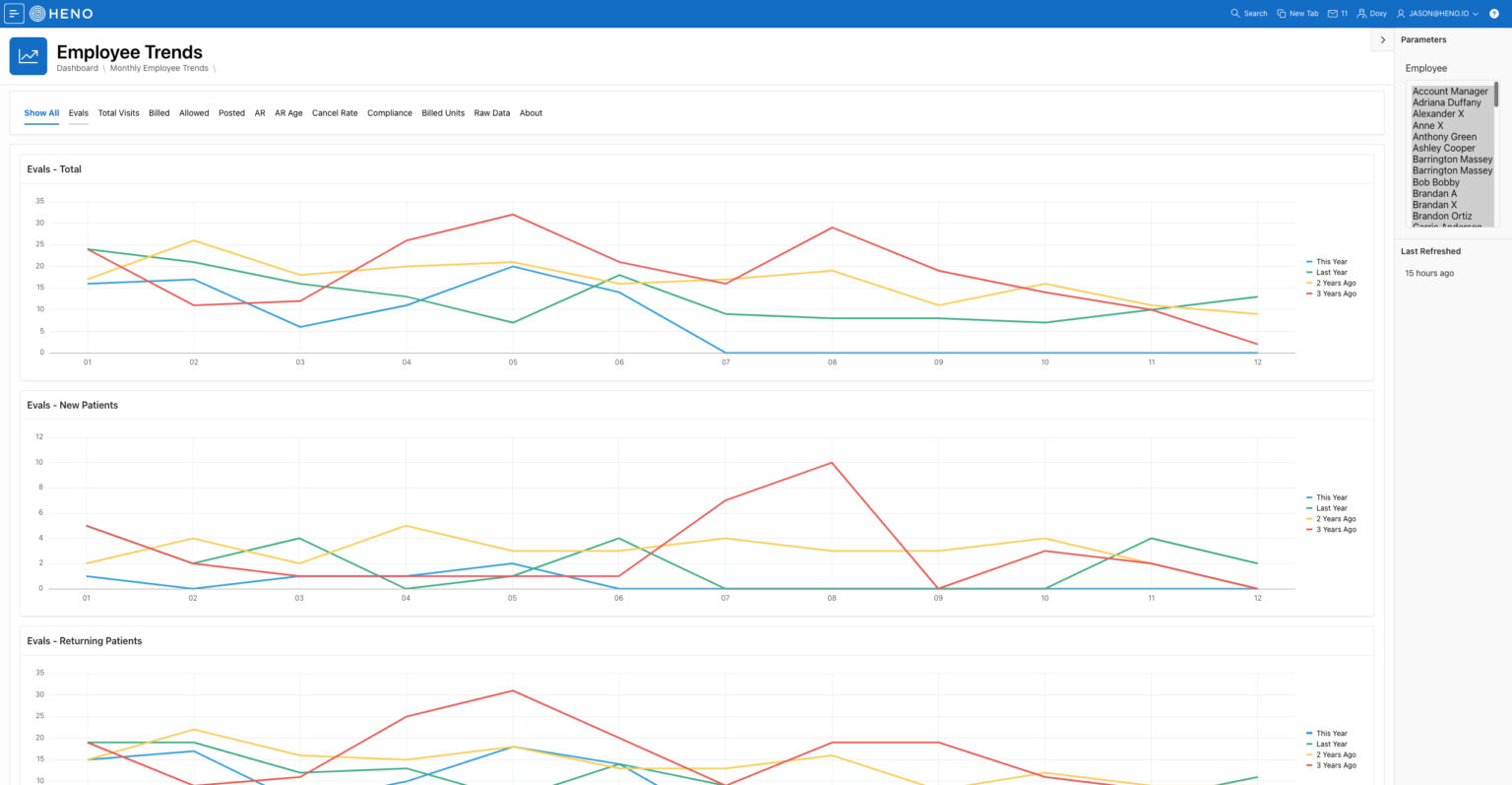Physical Therapy Billing Services
Physical Therapy Billing Services for PT, OT, & SLP. Ditch the hassles of billing, and entrust certified US-Based billing experts to process all your insurance claims, so you can focus on patient care!
Tired of Billing Headaches? Let HENO’s Integrated EMR & US-Based Physical Therapy Billing Services Fix That Today!
Stop Losing Money with Reliable PT Billing Services
$262 Billion Denied Annually
Recent research has shed light on a concerning statistic: a staggering $262 billion in insurance claims are denied annually in the United States. What’s even more alarming is that between 40% to 60% of these denials are never resubmitted. These numbers should give you pause. Not only will HENO’s Physical Therapy Billing Services empower you to bid farewell to the headaches of billing, but more importantly all our staff members are HENO Certified, so you better believe we’ll battle the insurance companies on your behalf. Our PT Billing Services let you stay in the billing fight with confidence.
In a landscape where insurance companies adopt a deny claims first, ask questions later approach, diligent therapists must seek out Physical Therapy Billing Services that empower their success, effectively combating these insurance obstacles so you can have your time and your life back. While having aesthetically pleasing documentation software is a plus, it holds little value if it fails to secure timely payments. HENO’s RCM and Billing Services are the lifeline for financial sustainability, and without robust billing software, your clinic’s revenues may fall victim to the voracious appetite of insurance companies.
However, many clinicians face a significant challenge: they lack familiarity with the intricacies of billing, and that’s where professional Physical Therapy Billing Services come in. To learn more about how HENO can maximize your reimbursements and reduce your headaches, setup a call with a PT RCM Services expert today. It just might be the best Zoom call you have for a long time.
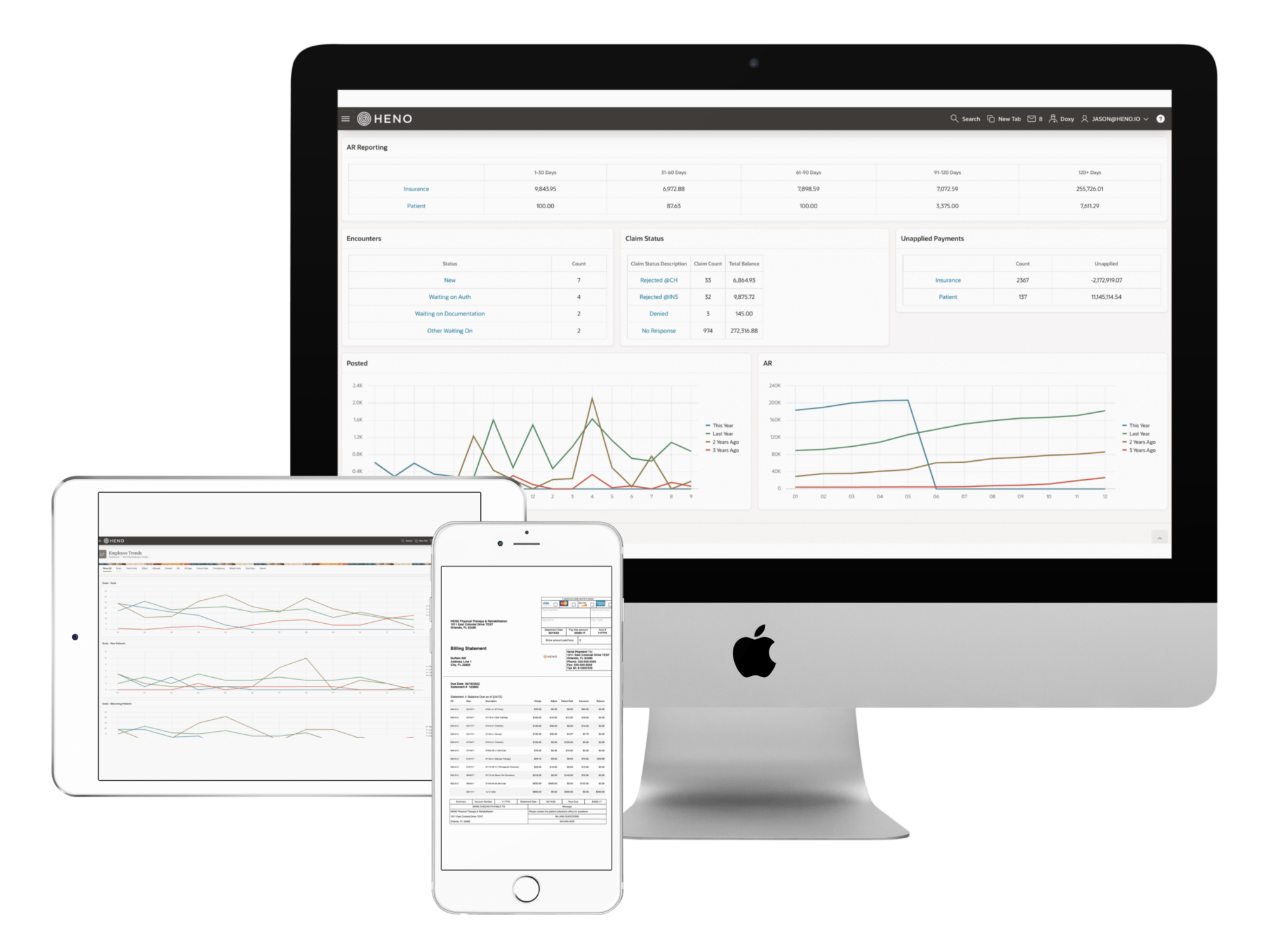
US-Based Physical Therapy Billing Services
Tired of The Never Ending Billing Headaches?
We know a thing or two about how hard Insurance Companies make it to get reimbursed. After successfully launching a string of successful clinics we decided to solve problems for other clinics by offering US-Based Physical Therapy Billing Services. Now we serve PT, OT, and SLP clinics across the USA – removing their billing headaches, and providing a great, all-in-one software and services experience. Now, hundreds of happy therapists are able to fully focus on patient care because we’ve removed their billing hassles.
Our Physical Therapy Billing Services Include:
- All HENO billing staff are based in the USA
- Enter claims, Review & submit e-claims, fix rejections & denials
- Accounts Receivable follow-up calls with insurance companies
- Payment Posting
- Patient Statements (text, email, and print)
- Patients can access Toll Free Billing hotline to make payments, and ask questions
- US-Based Billing Staff, and Account Manager For Life
Finally, Some Accountability
Integrated EMR & US-Based Physical Therapy Billing Services
The benefits of opting for a single solution, EMR and Billing Service, should not be underestimated. Dealing with multiple software vendors can already be challenging, and incorporating an external billing service into the mix can further complicate matters. There’s an old saying that highlights the advantages of having “one throat to choke” when problems arise. While no one intends for any actual “choking” to occur, the phrase emphasizes an important benefit of a single solution – when issues occur, there’s one point of contact for resolution.
- Streamlined Integration: When using a single company for both physical therapy billing services and electronic medical record (EMR) software, you benefit from seamless integration between the two systems. This integration allows for easy transfer of patient information, treatment plans, and documentation, eliminating the need for manual data entry and reducing
- Efficient Workflows: By using a unified platform for billing services and EMR, you can optimize workflows and enhance efficiency. Therapists and staff can access patient records, document treatment sessions, and initiate billing processes all within a single interface, saving time and reducing
- Improved Accuracy and Compliance: A single company offering both billing services and EMR ensures consistency in data entry and coding practices. This promotes accurate documentation, coding compliance, and reduces the risk of billing errors or audits.
- Real-Time Data Access: Having billing services and EMR software from the same company enables real-time data synchronization. This means that as billing transactions occur, such as claims submissions or payments, the information is immediately reflected in the patient records and financial reports, providing up-to-date insights into the clinic’s financial performance.
- Enhanced Financial Management: The integration of billing services and EMR software facilitates comprehensive financial management. You can generate financial reports, track revenue, monitor reimbursement trends, and identify potential issues or areas for improvement. This holistic approach to financial management helps clinics make informed decisions and optimize revenue.
- Simplified Vendor Relationship: Working with a single company for both billing services and EMR software reduces the complexity of managing multiple vendors. You have a single point of contact for support, updates, and training, streamlining communication and reducing potential challenges associated with coordination between different providers.
- Cost Efficiency: Using a single company for billing services and EMR can offer cost savings in terms of software licensing, maintenance, and support fees. Bundled pricing models or discounts may be available, resulting in potential financial benefits for the clinic.
- Seamless Transition and Implementation: When both billing services and EMR software are provided by the same company, the transition and implementation process can be smoother. The company can assist with data migration, training, and support, ensuring a cohesive and efficient setup for both systems.
PT Billing Services Pricing
Flexibly Priced Physical Therapy Billing Services
We understand that competitive pricing is critical. HENO Physical Therapy Billing Services offers a great Return on Investment by providing a single price for both EMR & Physical Therapy Billing Services. Here’s how it works.
- Customers Provide HENO an estimate of their volume
- HENO creates a personalized pricing quote for Unified EMR & Physical Therapy Billing Services
- Usually, customers pay the higher of a monthly minimum, or a percentage of collections. This means clients gain the benefits of having access to all of the software features, and getting unlimited therapist user logins for the same price
Billing Analytics
PT Billing Services Analytics
Many Physical Therapy Billing Services fall short when it comes to transparency. In short, if a PT Billing Services company doesn’t provide you with transparent reporting, it’s next to impossible to trust them let alone hold them accountable. HENO has an array of completely transparent dashboards to keep you in the loop about your finances at all times.
- Claims by status
- Payments Posted
- Accounts Receivable Aging
- Claim-level notes about who worked the claim last, what notes they added, and the date/time stamps of those notes. You’ll also be able to see if HENO billing staff are staying on top of their follow-up dates
- HENO’s advanced Physical Therapy Billing Services analytics lets you have your cake and eat it too since you get to ditch the billing headaches without losing control of the process
Features Overview
PT Billing Services Features Overview
HENO is the only Physical Therapy Billing Services platform with everything you need and nothing you don’t!
- Physical Therapy EMR & Custom Documentation
- Practice Management Software
- Appointment Automations to Fill Up Your Calendar
- Marketing Automation Software
- Patient Portal & Digital Intake Software
- Cash-Based PT Software, and General Store
#1 Rated Physical Therapy Billing Services & Integrated EMR
Millions
of Claims Submitted
50
States
#1
Rated
Frequently Asked Questions about Physical Therapy Billing Services
Physical therapy billing services refer to the outsourced administrative support provided to physical therapy practices for managing the billing and revenue cycle processes. These services are designed to handle tasks such as insurance claims submission, payment posting, patient billing, denial management, and revenue analysis.
Professional Physical Therapy Billing Services providers have expertise in navigating the complex landscape of medical billing, including the specific requirements and regulations related to physical therapy. They employ trained billing specialists who are well-versed in coding, documentation, and compliance. By outsourcing these tasks, physical therapy practices can streamline their operations and focus more on patient care.
Physical Therapy Billing Services are one of the most critical products or services a PT clinic can purchase. Accurate and efficient billing is crucial for the financial health of any physical therapy practice. Here are some key reasons why physical therapy billing services are essential:
a) Revenue Optimization: Professional billing services ensure that claims are submitted accurately and promptly, minimizing the risk of denials or delayed payments. This results in optimized revenue collection and improved cash flow for the practice.
b) Compliance with Regulations: The healthcare industry is constantly evolving, with frequent changes in coding requirements, billing guidelines, and insurance policies. Physical therapy billing services stay up to date with these changes, ensuring compliance and reducing the risk of penalties or legal issues.
c) Time and Cost Savings: Managing the billing process in-house can be time-consuming and costly. By outsourcing billing services, practices can free up valuable staff time, reduce administrative overhead, and minimize the need for expensive software and infrastructure investments.
d) Focus on Patient Care: Billing and revenue cycle management can be complex and demanding. By delegating these tasks to experts, physical therapy practitioners can dedicate more time and energy to providing high-quality patient care and improving outcomes.
The Role of Technology in Billing Services:
Technology plays a pivotal role in modern physical therapy billing services. Here are some ways in which technology enhances the billing process:
a) Practice Management Software: Billing service providers utilize advanced practice management software that integrates billing, scheduling, documentation, and reporting functionalities. This software streamlines workflows, ensures accurate data capture, and facilitates efficient communication between different stakeholders.
b) Electronic Health Records (EHR): EHR systems enable seamless documentation, storage, and retrieval of patient information. Billing services leverage EHR integration to access patient data, code accurately, and generate claims efficiently, reducing errors and improving reimbursement rates.
c) Coding and Compliance Tools: Technology-driven billing services employ automated coding tools that help ensure accurate and compliant coding practices. These tools assist in selecting appropriate codes based on the provided documentation, reducing the risk of errors and claim denials.
d) Claims Submission and Payment Processing: Billing services utilize electronic claims submission methods, such as HIPAA-compliant electronic data interchange (EDI), to transmit claims securely to insurance payers. This accelerates claim processing and minimizes the need for manual paperwork. Electronic payment processing systems are also employed to facilitate faster and more efficient reimbursement.
e) Analytics and Reporting: Billing service providers employ robust analytics and reporting tools to generate meaningful financial reports, track key performance indicators, and identify areas for improvement. These insights help practices make data-driven decisions to enhance revenue cycle management and overall financial performance.
In conclusion, physical therapy billing services provide valuable support to practices by managing the complexities of billing, revenue cycle management, and compliance. Leveraging technology in these services enhances efficiency, accuracy, and financial outcomes. By outsourcing billing tasks to experts and embracing technology-driven solutions, physical therapy practices can optimize their revenue, improve compliance, and allocate more time and resources to patient care.
Physical therapy billing services offer a range of benefits that contribute to enhanced revenue cycle management. These services optimize the billing process, ensuring accurate and timely submission of claims, efficient payment posting, and effective denial management. By streamlining revenue cycle activities, clinics can experience improved cash flow, minimized revenue leakage, and increased revenue collection.
Increased Efficiency and Time Savings: Outsourcing billing services allows physical therapy practices to focus on their core expertise, patient care, while eliminating the time-consuming administrative tasks associated with billing. Professional billing services handle the entire billing process, including claim preparation, submission, and follow-up. This results in increased operational efficiency, reduced administrative burden, and more time for therapists to dedicate to patient treatment.
Reduction in Billing Errors and Denials: Billing errors and claim denials can have a significant impact on revenue and productivity. Physical therapy billing services have extensive knowledge of coding guidelines and regulations, reducing the likelihood of errors and denials. They employ trained billing specialists who ensure accurate documentation, proper coding, and compliance with payer requirements, minimizing the risk of claim rejections and maximizing reimbursement rates.
Compliance with Changing Regulations: The healthcare industry is constantly evolving, with frequent changes in billing regulations, coding guidelines, and insurance policies. Physical therapy billing services stay updated with these changes, ensuring compliance and minimizing the risk of penalties or legal issues. They employ experts who are well-versed in the latest industry standards, enabling clinics to navigate the complex regulatory landscape with ease and confidence.
Improved Financial Reporting and Analytics: Physical therapy billing services provide advanced financial reporting and analytics capabilities. They generate comprehensive reports on key performance indicators, financial trends, and reimbursement rates. These insights help clinics monitor their financial health, identify areas for improvement, and make informed business decisions. By having access to accurate and timely financial data, clinics can optimize their revenue strategies and drive overall financial success.
In summary, physical therapy billing services offer a range of key benefits. They enhance revenue cycle management by optimizing billing processes, increase efficiency and save time for therapists, reduce billing errors and denials, ensure compliance with changing regulations, and provide improved financial reporting and analytics. By leveraging these services, physical therapy practices can streamline their operations, improve financial performance, and focus on delivering exceptional patient care.
Expertise and Experience in the Industry
When selecting a physical therapy billing service, it is crucial to consider the provider’s expertise and experience in the healthcare industry. Look for a company that specializes in medical billing for physical therapy practices. Their knowledge of industry-specific billing codes, regulations, and documentation requirements will ensure accurate claims submission and maximize reimbursement rates.
Integration with Practice Management Systems: Efficient integration between Physical Therapy Billing Services and your practice management software system is vital for seamless operations. Ensure that the billing service has the capability to integrate with your existing software, such as electronic health records (EHR) or practice management systems. This integration streamlines workflows, minimizes data entry errors, and improves overall efficiency. Or, better yet, if you can find a single company that owns the Billing Software, EMR Software, Practice Management Software, and the Billing Services, then your clinic will be significantly more efficient.
Transparent Pricing Models: Evaluate the pricing models offered by different billing service providers. Seek transparency in pricing structures, including any upfront costs, transaction fees, or additional charges for specific services. Clear understanding of the costs involved will help you make informed decisions and budget effectively for billing services.
Data Security and HIPAA Compliance: Given the sensitive nature of patient information, data security is of utmost importance. Choose a billing service provider that adheres to strict data security protocols and is compliant with the Health Insurance Portability and Accountability Act (HIPAA). Verify their measures for data encryption, secure storage, and secure transmission of patient data to ensure the privacy and confidentiality of patient information.
Customer Support and Assistance: Consider the level of customer support and assistance provided by the billing service provider. Timely and responsive support is crucial in addressing any billing-related issues or inquiries promptly. Look for a provider that offers dedicated account managers or customer support representatives who can assist with your specific needs and ensure a smooth billing process.
In the ever-evolving landscape of healthcare, successful physical therapy billing services require adherence to best practices that optimize revenue cycle management, ensure compliance, and streamline workflows. This comprehensive article explores key best practices for achieving success in physical therapy billing services, with a focus on clear communication, accurate documentation and coding, regular auditing and quality assurance, keeping up with industry changes, and embracing technology for streamlined workflows. By following these best practices, physical therapy practices can enhance their financial performance, improve efficiency, and deliver exceptional patient care.
Establishing Clear Communication Channels
Clear and effective communication is the foundation of successful billing services. Establishing robust communication channels between the physical therapy practice and the billing service provider is essential for seamless operations. Consider the following best practices:
a) Regular Meetings: Schedule regular meetings or conference calls with the billing service provider to discuss any billing-related concerns, updates, or changes in practice policies. These meetings foster a collaborative relationship and ensure that both parties are aligned in their approach.
b) Defined Points of Contact: Designate specific points of contact from both the practice and the billing service provider. This ensures clear lines of communication and facilitates prompt resolution of any billing issues or inquiries.
c) Timely Communication: Promptly communicate any changes or updates in patient information, insurance coverage, or billing requirements to the billing service provider. Similarly, the billing service provider should communicate any denials, rejections, or payment discrepancies in a timely manner to the practice.
d) Documentation of Communication: Maintain a record of all communication between the practice and the billing service provider. This documentation serves as a reference and can help address any discrepancies or misunderstandings that may arise in the future.
e) Addressing Concerns: Encourage open and transparent communication between the practice and the billing service provider. Promptly address any concerns, questions, or issues that may arise, and work collaboratively to find effective solutions.
By establishing clear communication channels, physical therapy practices can ensure that billing processes run smoothly, reduce errors, and improve overall efficiency.
Accurate Documentation and Coding
Accurate documentation and coding are vital for successful billing services. Proper coding ensures that services rendered by physical therapists are appropriately classified and billed, leading to accurate reimbursement. Follow these best practices for accurate documentation and coding:
a) Thorough Documentation: Physical therapists should provide detailed and comprehensive documentation of patient encounters, including evaluation findings, treatment plans, progress notes, and outcomes. Clear and concise documentation ensures accurate coding and supports medical necessity.
b) Standardized Documentation Templates: Implement standardized documentation templates that capture all essential elements required for coding and billing. These templates promote consistency, reduce documentation errors, and facilitate efficient coding processes.
c) Coding Compliance: Stay updated with the latest coding guidelines and regulations, such as the Current Procedural Terminology (CPT) codes, Healthcare Common Procedure Coding System (HCPCS) codes, and International Classification of Diseases (ICD) codes. Ensure accurate and compliant coding practices to minimize the risk of denials or audits.
d) Ongoing Education and Training: Provide regular education and training sessions for physical therapists and billing staff to enhance their understanding of coding guidelines, documentation requirements, and compliance standards. This empowers them to accurately document services and select appropriate codes.
e) Quality Assurance Processes: Implement quality assurance processes to review and audit documentation regularly. Conduct internal audits or enlist the help of external auditors to ensure compliance, identify any documentation gaps or errors, and provide feedback for improvement.
By emphasizing accurate documentation and coding practices, physical therapy practices can improve reimbursement rates, reduce claim denials, and maintain compliance with coding guidelines and regulations.
Regular Auditing and Quality Assurance is a must. This is an important topic, so we will cover this at length.
Regular auditing and quality assurance are critical components of successful physical therapy billing services. These practices ensure that billing processes are accurate, compliant, and efficient, leading to optimized revenue and minimized risks. Here are key considerations for implementing regular auditing and quality assurance:
a) Internal Audits: Conduct periodic internal audits of billing records, coding practices, and documentation to ensure compliance with industry standards and guidelines. These audits help identify any discrepancies, errors, or areas for improvement. By reviewing claims, coding accuracy, and documentation quality, practices can address issues proactively and enhance their billing processes.
b) External Audits: Engage external auditors, such as certified coding specialists or compliance consultants, to perform independent audits of billing practices. External audits provide an unbiased assessment of the practice’s compliance and help identify potential vulnerabilities or areas requiring attention. The findings from external audits can guide the implementation of corrective measures and further improve the billing process.
c) Claims Denial Analysis: Analyze claim denials on a regular basis to identify patterns, root causes, and trends. By understanding the reasons for denials, practices can implement corrective actions, such as staff training, process improvements, or enhanced documentation, to reduce denials and improve reimbursement rates.
d) Documentation Reviews: Conduct thorough reviews of patient documentation to ensure completeness, accuracy, and compliance with coding and billing requirements. Verify that all services provided are properly documented and supported by medical necessity. Regular documentation reviews help identify potential gaps or inconsistencies, enabling practices to address them promptly and avoid billing errors or denials.
e) Ongoing Staff Training: Provide regular training to billing staff, coding specialists, and physical therapists to keep them updated on industry changes, coding guidelines, and compliance regulations. Continuous education ensures that staff members stay informed about best practices, new coding updates, and any changes in billing requirements. Training sessions also reinforce the importance of accuracy, compliance, and quality in the billing process.
By implementing regular auditing and quality assurance practices, physical therapy practices can minimize errors, reduce claim denials, and enhance the overall efficiency of their billing services.
Keeping Up with Industry Changes
The healthcare industry is continuously evolving, with frequent changes in regulations, coding guidelines, payer policies, and reimbursement models. To ensure successful physical therapy billing services, practices should make sure billing services they choose are staying abreast of industry changes. Here are key strategies Physical Therapy Billing Services should follow to keep up with industry changes:
a) Industry Associations and Resources: Join professional associations related to physical therapy billing or revenue cycle management. These associations often provide resources, webinars, conferences, and publications that keep members informed about the latest industry changes. Participate in these events and leverage the knowledge shared by industry experts.
b) Regular Communication with Payers: Stay in touch with insurance payers to understand any changes in their policies, billing requirements, or reimbursement rates. This direct communication allows practices to adapt their billing processes accordingly and ensure compliance with payer-specific guidelines.
c) Continuous Education and Training: Invest in continuous education and training for billing staff and coding specialists. Offer opportunities for professional development, such as attending seminars, webinars, or workshops focused on industry changes, coding updates, and compliance regulations. This empowers staff members to adapt to evolving industry requirements and effectively manage billing processes.
d) Collaborate with Billing Service Providers: If working with an external billing service provider, maintain regular communication to stay informed about industry changes and updates. Collaborate with the billing service provider to ensure that they are adapting their processes and software to align with new regulations and requirements.
e) Regular Policy and Procedure Review: Conduct periodic reviews of internal policies and procedures related to billing, coding, and compliance. Ensure that these policies are up to date with current industry standards and guidelines. Revise and communicate policies as needed to reflect changes in regulations and requirements.
f) Industry News and Publications: Stay informed by regularly reading industry news and publications that focus on healthcare regulations, billing practices, and reimbursement trends. Subscribe to relevant newsletters, blogs, and publications to receive updates directly in your inbox. This allows you to stay informed about the latest industry changes and adapt your billing processes accordingly.
g) Networking and Collaboration: Engage in networking opportunities with peers, industry professionals, and billing experts. Attend conferences, workshops, or webinars where you can connect with others in the field. Collaborate and share insights to stay informed about emerging trends, challenges, and best practices in physical therapy billing services.
By actively keeping up with industry changes, physical therapy practices can adapt their billing processes, remain compliant, and maximize their revenue potential.
Technology plays a pivotal role in optimizing physical therapy billing services and streamlining workflows. Embracing technological solutions can enhance efficiency, accuracy, and overall productivity. Ask your potential Physical Therapy Billing Services if they are doing the following:
a) Integrated Practice Management Software: Invest in a robust practice management software system that integrates billing, scheduling, documentation, and reporting functionalities. This centralized solution eliminates the need for multiple disjointed systems, allowing for seamless data flow and improved efficiency. With integrated software, information entered once in the system automatically populates across various functions, reducing manual data entry and minimizing errors.
b) Electronic Health Records (EHR): Implement an electronic health records (EHR) system designed specifically for physical therapy practices. EHRs streamline documentation processes by providing standardized templates, automated data capture, and secure storage of patient records. This technology improves accuracy, accessibility, and compliance with documentation requirements.
c) Automated Billing and Claims Submission: Leverage technology to automate billing processes, including claims submission and payment posting. Utilize billing software that enables electronic claims submission, reducing manual paperwork and accelerating reimbursement. Automation reduces the risk of errors, improves cash flow, and minimizes delays in reimbursement.
d) Revenue Cycle Analytics: Utilize analytics tools and reporting capabilities within your billing software to gain insights into key performance indicators (KPIs) and financial trends. Analyze data related to claims, denials, reimbursement rates, and overall revenue. This enables data-driven decision-making and helps identify areas for improvement in the revenue cycle.
e) Patient Portal and Online Payment Options: Implement a patient portal that allows patients to access their billing statements, make online payments, and communicate securely with the practice. This technology improves patient satisfaction, reduces administrative tasks, and expedites the payment process.
f) Regular Technology Updates: Stay updated with the latest advancements in billing software and technology solutions. Regularly evaluate your current software and consider upgrades or enhancements that align with evolving industry standards and requirements. Engage with technology vendors and attend webinars or conferences to stay informed about new features and functionalities that can streamline workflows.
By embracing technology, physical therapy practices can enhance efficiency, accuracy, and overall effectiveness in their billing services. Technology-driven solutions streamline workflows, improve data management, and free up valuable time for therapists and staff to focus on delivering high-quality patient care.
Here’s a checklist of questions to ask a potential physical therapy billing services vendor to gain a better understanding of their qualifications:
- What experience do you have in providing billing services specifically for physical therapy practices?
- Are your billing specialists trained in physical therapy-specific coding and billing requirements?
- How do you ensure compliance with coding guidelines, regulations, and payer policies?
- What types of software or technology do you utilize for billing services, and are they compatible with our practice management system or electronic health records (EHR) system?
- How do you handle claims denials and appeals? What kind of tracking do you use to ensure Denials are worked, and how can I see these dashboards?
- How do you ensure data security and compliance with HIPAA regulations?
- What is your process for handling patient inquiries or concerns related to billing?
- Can you provide reporting and analytics on key performance indicators (KPIs) and financial trends?
- What is your pricing structure? Are there any additional fees or charges for specific services?
- How do you handle the transition and onboarding process for new clients?
- Do you offer dedicated account managers or customer support representatives?
- What is your average turnaround time for claims submission and payment posting?
- How do you stay updated with industry changes, coding updates, and billing regulations?
- Can you provide any case studies or success stories from your current or past clients in the physical therapy industry?
Asking these questions will help you assess the vendor’s qualifications, experience, technological capabilities, and commitment to compliance and customer satisfaction. It will enable you to make an informed decision when selecting a physical therapy billing services vendor for your practice.
